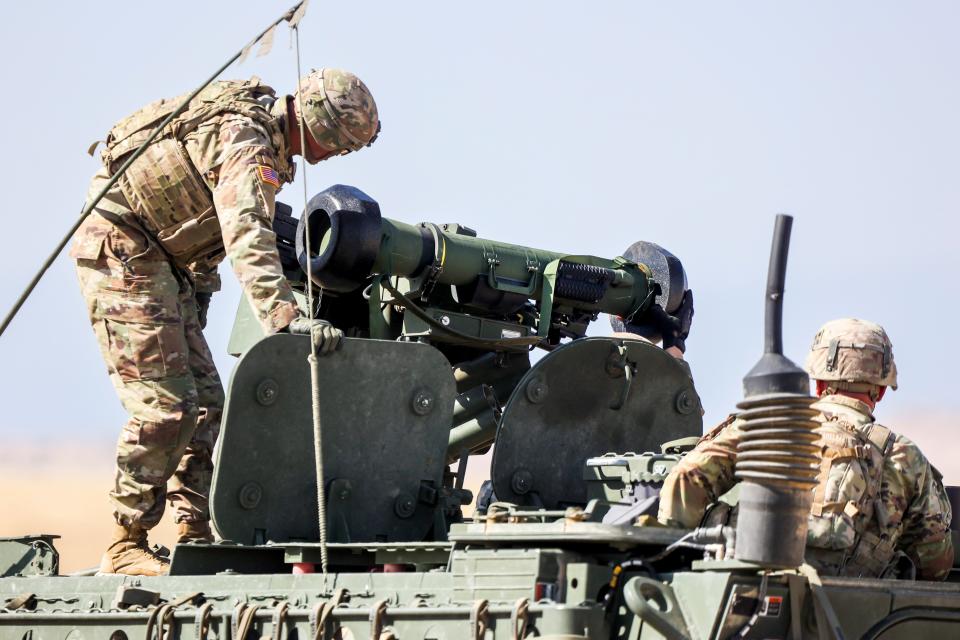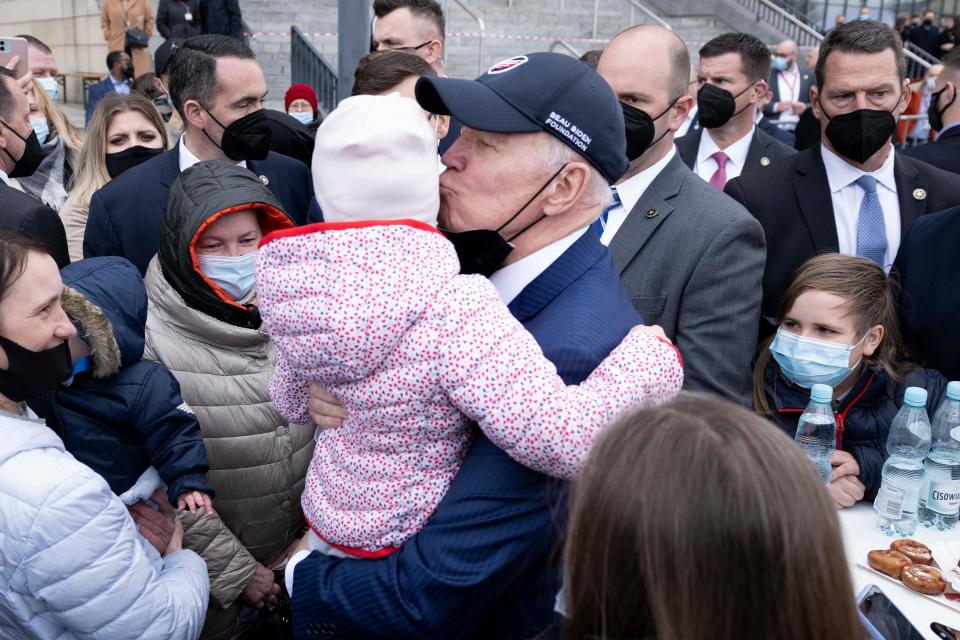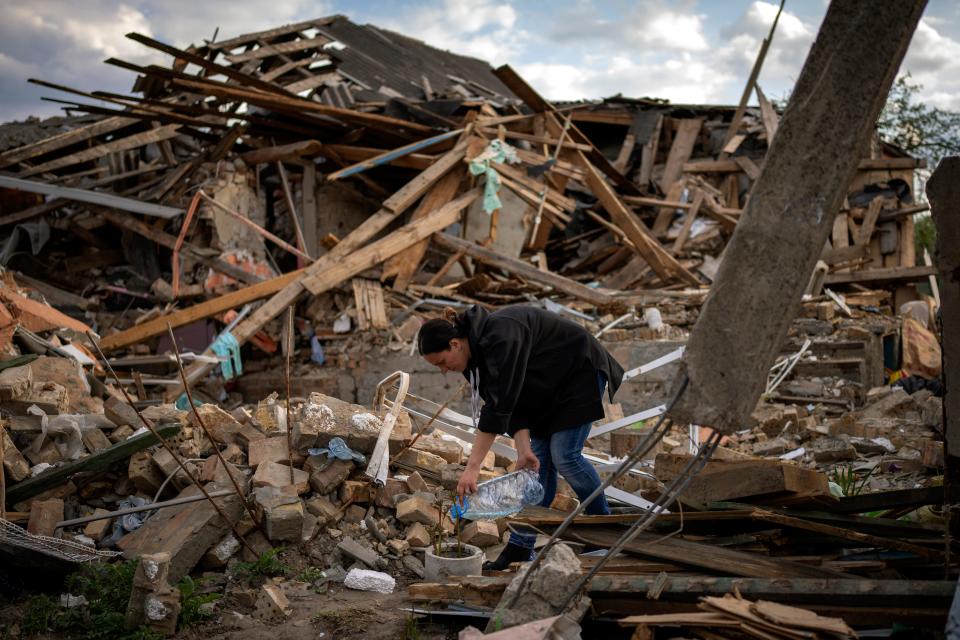US aid to Ukraine could hit $53B. Here's what it covers, how it compares and who pays for it
WASHINGTON – Congress is poised to approve more than $40 billion in emergency funding to support Ukraine, an amount nearly three times greater than what the U.S. has already committed in military, humanitarian and other assistance to beat back Russia's invasion.
Along with the $13.6 billion passed in March, the combined $53.7 billion is about 81% of Russia’s 2021 defense budget.
It’s more than one-quarter the size of Ukraine’s pre-war economy.
And it’s slightly more than the 2021 joint budget for the State Department and U.S. Agency for International Development.
The House approved the new $40.1 billion package last week, after adding to the $33 billion in assistance President Joe Biden requested last month. Sen. Rand Paul, R-Ky., derailed plans to fast-track the legislation in the Senate over his insistence that a new inspector general oversee the spending. The Senate passed the bill Thursday.
That level of spending is “extremely significant” given the size of Ukraine, said Benn Steil, director of international economics and the official historian in residence at the Council on Foreign Relations.
“What Biden is saying is that (Russian) President (Vladimir) Putin cannot come out of this conflict with a winning narrative, because that would be very dangerous for the United States,” Steil said. “It would embolden U.S. adversaries, and it would raise the odds of a bordering NATO country getting sucked into the conflict.”
Unveiling the funding request he sent to Congress in April, Biden acknowledged the high price tag.
“The cost of this fight is not cheap,” he said, “but caving to aggression is going to be more costly if we allow it to happen.”

Doug Rediker, a senior fellow in the Global Economy and Development program at the Brookings Institution, said Biden is absolutely right.
“If this war continues, and spirals into something more widespread, and more directly involving NATO, Europe, and even the United States,” Rediker said when the request was released, “then, in terms of the human cost, the military cost and the economic cost, it is potentially exponentially greater than the sums that were suggested today.”
If approved, the funding is expected to be added to the deficit, as the March package was. But at least some sectors of the U.S. economy could benefit. Most significantly, weapons manufacturers would benefit from new orders needed to replace what the United States is giving to Ukraine.
Here’s a look at how to understand the funding request:
What’s the new Ukraine funding request?
Biden asked Congress to approve $33 billion, which included more than $20 billion in military and other security assistance, $8.5 billion in economic assistance, and $3 billion in humanitarian assistance.
The House-passed package increased the amount of funding for defense and humanitarian programs.
The administration has said its pending request is the amount needed for the next five months, which would get to the end of the federal fiscal year, on Sept. 30.
“As long as the assaults and atrocities continue,” Biden said, “we’re going to continue to supply military assistance.”
What Ukraine funding has already been approved?
In March, Congress approved $13.6 billion in emergency spending. That included $6.5 billion for the Defense Department to replenish stocks of equipment sent to Ukraine, to deploy U.S. troops in the region and provide intelligence support. Nearly $6 billion went to humanitarian and economic support for the region.
What’s the combined amount of funding for Ukraine?
If Congress approves the latest request, the combined amount would be $53.7 billion.
To put that in perspective, it's about as much as the $54 billion spent to help passenger airlines keep workers on their payroll during the pandemic. It’s close to the size of Harvard University’s $53.2 billion endowment last year. And it's as large as Maryland's 2021 budget.
How significant is the new military aid portion?
The $20 billion Biden requested in military and other security assistance is dwarfed by the administration’s $773 billion proposed budget for the Pentagon. It’s even tinier juxtaposed against the more than $2.3 trillion the U.S. spent on the 20-year war in Afghanistan.
But since the U.S. fielded its own forces in Afghanistan, the appropriate comparison is with the military assistance it directly gave to the Afghans, said Neta Crawford, co-director of Boston University’s Costs of War project.

Financing for Afghanistan to purchase its own weapons totaled about $3 billion. The U.S. spent about another $1.6 billion on military education and training. Biden's second request for Ukraine included $4 billion in foreign military financing and $11.4 billion for training, equipment transfers and advisory efforts. The House-passed bill upped the amount of funding to replenish U.S. stocks of equipment sent to Ukraine.
“When you look at it that way, this is a significant chunk,” Crawford said of the assistance to Ukraine.
A February transfer of $350 million worth of military equipment to Ukraine was the largest presidential drawdown package in history, according to the Pentagon. Some of the subsequent drawdowns – which are transfers of U.S. stocks that are later replenished – have been even larger.
Even before Russian troops attacked in February, Ukraine was a leading recipient of U.S. military aid in Europe and Eurasia. In between Russia’s annexation of Crimea in 2014 and the start of the latest invasion, the U.S. provided nearly $3 billion in assistance. Since then, Crawford notes, “We’ve given as much in the last three months as we’ve given in the previous several years.”
How much would be spent on U.S. troops?
While Biden has ruled out direct military involvement in Ukraine, he has expanded U.S. military presence in NATO countries near Ukraine. The number of troops has grown from about 80,000 to 100,000.
The $2.6 billion Biden asked for to continue U.S. troop deployments there would not quite match the $3 billion already approved in the March spending package. The House approved even more than Biden requested: $3.9 billion.

How significant is direct support for Ukraine?
Biden requested $7.5 billion so Ukraine can continue critical government functions. The amount is significant, particularly as a signal that the U.S. is going beyond supporting Ukraine militarily, said Rediker of the Brookings Institution.
But $7.5 billion is also relatively small compared to the International Monetary Fund’s estimate that Ukraine needs about $5 billion a month to keep functioning. When the IMF helps, however, it provides loans, not grants. So the real support has to come from individual countries like the U.S. that are willing to step up, Rediker said.
“There is no global pool of funds, waiting to be drawn upon at a time of crisis,” he said.

How much would be spent on food assistance?
Among the humanitarian provisions approved by the House is more than $4.3 billion for emergency food assistance, both in Ukraine and for people around the world who depend on crops from the war-ravaged country.
That’s close to the entire current budget for the International Disaster Assistance program run by the U.S. Agency for International Development.
The package also includes $20 million to begin replenishing a humanitarian trust that provides emergency food assistance to developing countries. In April, the administration took what it called the extraordinary step of drawing down the entire $282 million in the fund to help Yemen and five African countries facing food shortages because of the war.
How much would be spent to increase U.S. crop production?
The administration had proposed spending $500 million to encourage U.S. farmers to grow more wheat and other crops to make up for shortfalls in global food production. Ukraine is one of the world’s largest exporters of wheat.
But the extra funding for crop insurance and marketing assistance loan programs was left out of the House bill.
The prices for wheat and other commodities are already so high that farmers have enough of an incentive to be growing those crops, said Anne Schechinger, Midwest director for the Environmental Working Group, which tracks farm subsidies.
“I don't think this is going to make much of a difference at all to U.S. ag producers,” Schechinger said of the administration's $500 million request.
It’s also a fraction of the $23 billion the government gave farmers in 2018-2019 to offset tariffs China placed on agriculture imports in retaliation for U.S. tariffs. And it’s much less than the $30 billion the federal government spent in 2020 on its Coronavirus Food Assistance Program.
How much would be spent on refugees?
Biden asked for $1.2 billion for financial, medical and other assistance to the up to 100,000 Ukrainian refugees arriving in the United States.
The president's request is equal to about 20% of current funding levels for the Department of Health and Human Service’s refugee and entrant assistance program.
The House reduced Biden’s requested bump for that program to $900 million but included an extra $54 million for the Centers for Disease Control and Prevention to provide medical screening for refugees.

How does this affect the budget deficit?
In the first half of the year, the federal government borrowed an average of $3.5 billion a day because it spent more than it collected in revenue. The aid is equal to nearly an additional 12 days of borrowing at that rate.
Does this include reconstruction?
None of the billions in new funding would go toward reconstruction, which Ukraine’s prime minister said in April would cost $600 billion. But along with the funding request sent to Congress, the administration proposed legislation “to streamline the process to recoup proceeds from seized and forfeited assets and use them to remediate the harm caused in Ukraine.”
Sanctions have frozen tens of billions of dollars in Russian government assets in the United States.
Secretary of State Antony Blinken told lawmakers last month that lawyers are looking at what legal authorities are needed to seize those assets and use them to rebuild Ukraine.
Even if the assets are used for reconstruction, American taxpayers could eventually end up footing the bill, according to Paul Stephan, a University of Virginia law school professor who has worked at the State and Defense departments.
“Russia will not always be a pariah,” Stephan wrote in a recent analysis for Lawfare. “When it returns to the fold, it will want its money back.”

This article originally appeared on USA TODAY: US aid to Ukraine could top $53 billion. Here's how it breaks down

 Yahoo Movies
Yahoo Movies 
